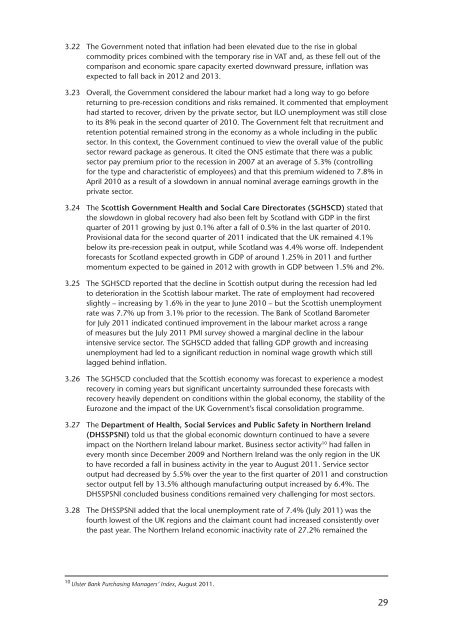NHS pay review body: twenty-sixth report 2012 - Official Documents
NHS pay review body: twenty-sixth report 2012 - Official Documents
NHS pay review body: twenty-sixth report 2012 - Official Documents
Create successful ePaper yourself
Turn your PDF publications into a flip-book with our unique Google optimized e-Paper software.
3.22 The Government noted that inflation had been elevated due to the rise in global<br />
commodity prices combined with the temporary rise in VAT and, as these fell out of the<br />
comparison and economic spare capacity exerted downward pressure, inflation was<br />
expected to fall back in <strong>2012</strong> and 2013.<br />
3.23 Overall, the Government considered the labour market had a long way to go before<br />
returning to pre-recession conditions and risks remained. It commented that employment<br />
had started to recover, driven by the private sector, but ILO unemployment was still close<br />
to its 8% peak in the second quarter of 2010. The Government felt that recruitment and<br />
retention potential remained strong in the economy as a whole including in the public<br />
sector. In this context, the Government continued to view the overall value of the public<br />
sector reward package as generous. It cited the ONS estimate that there was a public<br />
sector <strong>pay</strong> premium prior to the recession in 2007 at an average of 5.3% (controlling<br />
for the type and characteristic of employees) and that this premium widened to 7.8% in<br />
April 2010 as a result of a slowdown in annual nominal average earnings growth in the<br />
private sector.<br />
3.24 The Scottish Government Health and Social Care Directorates (SGHSCD) stated that<br />
the slowdown in global recovery had also been felt by Scotland with GDP in the first<br />
quarter of 2011 growing by just 0.1% after a fall of 0.5% in the last quarter of 2010.<br />
Provisional data for the second quarter of 2011 indicated that the UK remained 4.1%<br />
below its pre-recession peak in output, while Scotland was 4.4% worse off. Independent<br />
forecasts for Scotland expected growth in GDP of around 1.25% in 2011 and further<br />
momentum expected to be gained in <strong>2012</strong> with growth in GDP between 1.5% and 2%.<br />
3.25 The SGHSCD <strong>report</strong>ed that the decline in Scottish output during the recession had led<br />
to deterioration in the Scottish labour market. The rate of employment had recovered<br />
slightly – increasing by 1.6% in the year to June 2010 – but the Scottish unemployment<br />
rate was 7.7% up from 3.1% prior to the recession. The Bank of Scotland Barometer<br />
for July 2011 indicated continued improvement in the labour market across a range<br />
of measures but the July 2011 PMI survey showed a marginal decline in the labour<br />
intensive service sector. The SGHSCD added that falling GDP growth and increasing<br />
unemployment had led to a significant reduction in nominal wage growth which still<br />
lagged behind inflation.<br />
3.26 The SGHSCD concluded that the Scottish economy was forecast to experience a modest<br />
recovery in coming years but significant uncertainty surrounded these forecasts with<br />
recovery heavily dependent on conditions within the global economy, the stability of the<br />
Eurozone and the impact of the UK Government’s fiscal consolidation programme.<br />
3.27 The Department of Health, Social Services and Public Safety in Northern Ireland<br />
(DHSSPSNI) told us that the global economic downturn continued to have a severe<br />
impact on the Northern Ireland labour market. Business sector activity10 had fallen in<br />
every month since December 2009 and Northern Ireland was the only region in the UK<br />
to have recorded a fall in business activity in the year to August 2011. Service sector<br />
output had decreased by 5.5% over the year to the first quarter of 2011 and construction<br />
sector output fell by 13.5% although manufacturing output increased by 6.4%. The<br />
DHSSPSNI concluded business conditions remained very challenging for most sectors.<br />
3.28 The DHSSPSNI added that the local unemployment rate of 7.4% (July 2011) was the<br />
fourth lowest of the UK regions and the claimant count had increased consistently over<br />
the past year. The Northern Ireland economic inactivity rate of 27.2% remained the<br />
10 Ulster Bank Purchasing Managers’ Index, August 2011.<br />
29
















